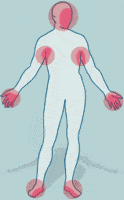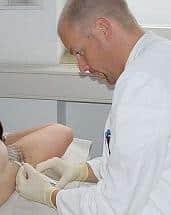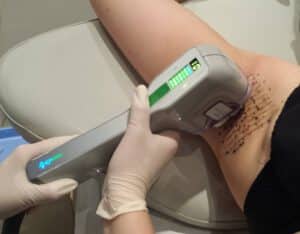The German Hyperhidrosis Center in Munich
– Your Solution to Excessive Sweating
AXHIDROX® is available now in Germany – maybe the „game changer“ for many hyperhidrosis sufferers? Does German health insurance pay? YES!! Where is more information? – well here on the website and as a video on our YouTube channel (in German).
Millions of people suffer from an excessive sweating condition known as ‚hyperhidrosis’. Hyperhidrosis can occur in many different parts of the body. Most commonly, hyperhidrosis appears on the hands (hyperhidrosis palmaris), the facial area (hyperhidrosis facialis),
Hyperhidrosis can occur in many different parts of the body. Most commonly, hyperhidrosis appears on the hands (hyperhidrosis palmaris), the facial area (hyperhidrosis facialis),  the soles of the feet (hyperhidrosis plantaris), and armpits (hyperhidrosis axillaris).
the soles of the feet (hyperhidrosis plantaris), and armpits (hyperhidrosis axillaris).
Hyperhidrosis of the face, the hands, and the armpits can be successfully cured by a surgical nerve block called ETS, ETS-C, ETSC, or ESB (endoscopic transthoracic sympathectomy, endoscopic sympathetic block with clips).
Hyperhidrosis of the feet can be cured by endoscopic lumbar sympathectomy = ELS.
Severe, spontaneous facial blushing can also be cured as long as the blushing is caused by sympathetic nerve overactivity (social situations, anxiety, stress).
Conservative treatment We offer almost all kinds of non-surgical treatment: external medication, iontophoresis, botulinum toxin (i.e. Dysport®, Botox®, Vistabel®, and others), systemic drug therapy, radiofrequency thermotherapy RFTT, and **NEW** miraDry® microwave thermolysis (thermotherapy). Laser therapy we suspended due to poor results.
We offer almost all kinds of non-surgical treatment: external medication, iontophoresis, botulinum toxin (i.e. Dysport®, Botox®, Vistabel®, and others), systemic drug therapy, radiofrequency thermotherapy RFTT, and **NEW** miraDry® microwave thermolysis (thermotherapy). Laser therapy we suspended due to poor results.
Local surgery
For axillary hyperhidrosis we offer sweat gland removal by retrodermal curettage or by skin excision. But: miraDry beats curettage!
miraDry® miraDry is a completely new type of treatment for axillary hyperhidrosis (excessive underarm sweating). It was cleared by the US FDA in January 2011 and in Germany in 2014. The miraDry treatment is non-invasive, painfree, and long lasting. miraDry is effective in treating both axillary (underarm) hyperhidrosis and axillary osmidrosis (foul-smelling sweat) also called bromhidrosis. The German Hyperhidrosis Center (DHHZ) in Munich offers this treatment since 2014 and is the first certified treatment center for miraDry in Germany. And: since 2015 we developped and improved miraDry as a treatment for sweating of the trunk, groin, and buttocks. Our experience for your safety.See this video for more Information.
miraDry is a completely new type of treatment for axillary hyperhidrosis (excessive underarm sweating). It was cleared by the US FDA in January 2011 and in Germany in 2014. The miraDry treatment is non-invasive, painfree, and long lasting. miraDry is effective in treating both axillary (underarm) hyperhidrosis and axillary osmidrosis (foul-smelling sweat) also called bromhidrosis. The German Hyperhidrosis Center (DHHZ) in Munich offers this treatment since 2014 and is the first certified treatment center for miraDry in Germany. And: since 2015 we developped and improved miraDry as a treatment for sweating of the trunk, groin, and buttocks. Our experience for your safety.See this video for more Information.

Sympathetic Surgery
Endoscopic thoracic sympathetic block (ETS-C, ESB) is a minimally invasive surgical treatment for hyperhidrosis.  The procedure is performed with the use of a video camera through two 6 millimeter incisions on each side of the chest. Through the video camera the sympathetic nerve is located in the chest and the nerve is blocked by titanium clamps at the level that corresponds to the patients sweating. To minimize side effects only one level is blocked (i.e. for palmar hyperhidrosis).
The procedure is performed with the use of a video camera through two 6 millimeter incisions on each side of the chest. Through the video camera the sympathetic nerve is located in the chest and the nerve is blocked by titanium clamps at the level that corresponds to the patients sweating. To minimize side effects only one level is blocked (i.e. for palmar hyperhidrosis).
The procedure is performed under a general anesthesia and takes approximately half an hour.  Following the procedure patients typically spend 2-3 nights in the hospital and are then released to home.
Following the procedure patients typically spend 2-3 nights in the hospital and are then released to home.
The sympathectomy procedures are typically done on Tuesdays and Wednesdays; and although recovery times vary, most patients from abroad return to school/work the following week.
Experience
The head of our center, Dr. Christoph Schick, is the most experienced surgeon in the field of ETS surgery in Germany. He developed neurophysiological tests to determine the compensatory sweating and introduced the clipping technique in Germany.
is the most experienced surgeon in the field of ETS surgery in Germany. He developed neurophysiological tests to determine the compensatory sweating and introduced the clipping technique in Germany.
Dr. Schick is founding member of the International Society of Sympathetic Surgery, and member of the European Federation of Autonomic Societies.
Side Effects of Sympathetic Surgery
The most typically seen side effect of the sympathetic block procedure is so called compensatory hyperhidrosis, which describes an increased sweating in other areas of the body. Since the sympathetic nerve not only gives the impulse to sweat, but also transports the information how much one is already sweating, blocking the sympathetic nerve to stop sweating in one area of the body causes more sweating in other locations – most typically the chest, back, abdomen, behind the knees, and inner thighs.
Mild to moderate compensatory hyperhidrosis occurs in all patients and is usually tolerable. Compensatory sweating can occur sporadically throughout the day or in summer heat or while exercising. This degree of sweating is usually tolerable but can be treated with oral medications. Most patients feel it is an acceptable trade off to having their face or hands dripping with sweat.
Severe compensatory hyperhidrosis occurs in approximately 10 percent of patients. We developed tools to estimate this effect. But there is no way to determine for sure which patients will be severely affected by compensatory sweating, but there are indicators of sweating prior to surgery that can help in making this determination. If a patient’s sweating is localized only to their hands or underarms they are less likely to get severe compensatory sweating.
A patient who has sweating of the back, chest, or legs in addition to hands or underarms prior to surgery is more likely to get severe compensatory symptoms following surgery. Although patients were able to get relief from their initial sweating, they sometimes regret having the procedure due to the severe nature of the compensatory sweating. There are oral medications that can help in the management of compensatory symptoms.
Gustatory sweating occurs when eating spicy foods and is typically sweating of the upper lip, forehead, or back of the neck.
Postoperatively, the heart rate is often diminished. Permanent states of bradycardia requiring treatment are, however, rare. Nevertheless, patients should be warned to expect a postoperative slowing of the heart rate at rest and under load. Although these changes are noticed by only few patients or, when palpitations due to emotional stress are noted to be reduced, may even be welcomed, the phenomenon may require a re-assessment of the performance of competitive athletes.
Following the sympathetic block procedure some patients have experienced extremely dry hands – even if their hands were not sweaty prior to surgery. Application of hand lotion regularly will help to minimize this effect.
Complications: Chest wall pain: some patients have experienced pain between the ribs at the site where the endoscope was inserted. This usually resolves within a couple of days postoperatively.
Horner’s Syndrome is a droopy eyelid and is due to an injury of the Stellate ganglion or the first thoracic (T1) sympathetic nerve and occurs in less than 0.1 percent of patients. Pneumothorax (collapsed lung), bleeding, infection, organ damage, thrombosis, or embolism, is rare.
A recurrence of symptoms is possible (~3 percent in hand sweating, 5-7 percent in facial sweating) and is a possible necessity for a redo operation.
Contact us
We welcome you for consultations and conservative or surgical treatment. You may contact us directly or through a referring physician. Please forward copies of your medical records from other physicians before your first appointment, which will be set for the earliest time and date possible.
The German Hyperhirosiscenter is the number one center of excellence for your hyperhidrosis and facial blushing problem in Germany. We care for you and find the best treatment solution for your problem. We offer all established and innovative treatment options.
Please contact us for more information:
German Hyperhidrosiscenter / Deutsches Hyperhidrosezentrum DHHZ
Head:
Christoph H. Schick, M.D.
Office:
Ms. Begic, Ms. Akca
We speak German, English, Turkish, Croatian, Slovenian, and Serbian.
Fax +49.89.27272013
or send us an e-mail to:
post@dhhz.de
Address:
German Hyperhidrosiscenter / Deutsches Hyperhidrosezentrum DHHZ
St.-Bonifatius-Str. 5
D-81541 München / Munich
Germany
Open Monday – Friday 9.30 a.m. – 3.30 p.m.
This website: www.hyperhidrosiscenter.com
